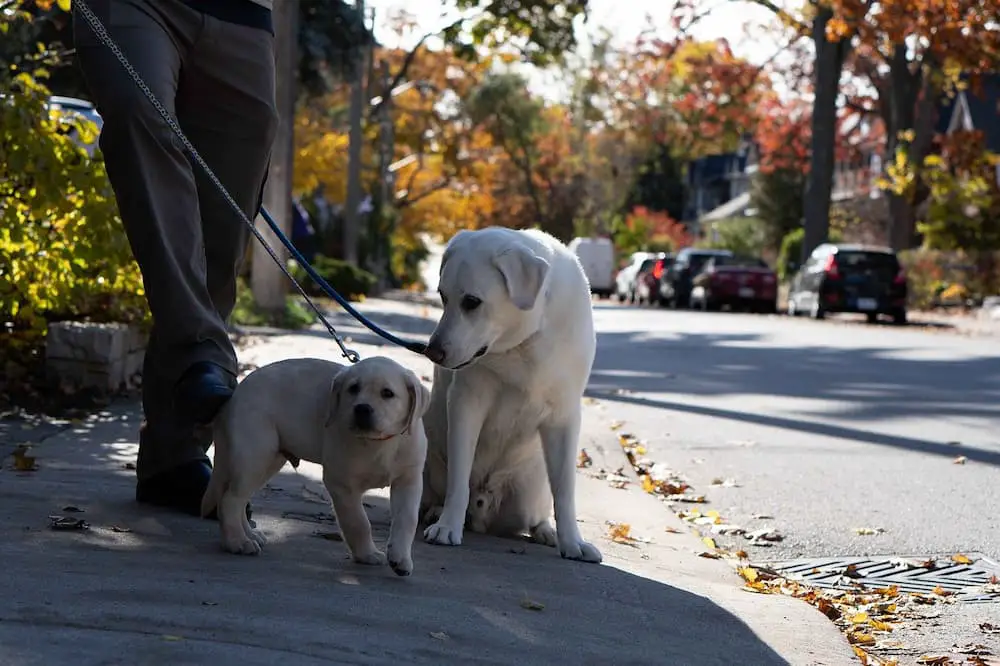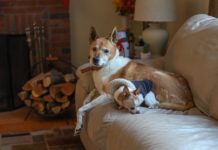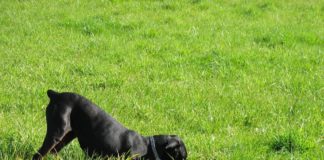Why Your Older Dog Won’t Leave Your New Puppy Alone?
There’re two types of dogs who won’t leave the other pets alone. The over-excited dogs who truly just want to play, but just get far too excited. Then there are the dogs that can get aggressive, attempting to provoke anything that comes near them.
Has Your Older Dog Been Socialized well?
It’s important to remember that dogs are very social animals. It’s what makes them such wonderful pets after all. However, they also need to be socialized with other dogs.
When in the wild, the relationships between other dogs are vital for survival and are why all wild dogs, including wolves, hunt in groups or packs.
In the wild, they communicate through body language, scent, and vocalizations. They form close bonds with others in the pack. They have an innate need for relationships with others within the pack. The younger dogs are taught how to act properly not only by their mother but other members of the pack.
Overexcitement
A dog that gets overexcited easily is like a young child. These types of dogs have little self-control and a single-minded focus, so once they reach an overexcitement level, it’s nearly impossible to reach them.
A dog that gets overexcited will encroach on other dogs and pups, bouncing and attempting to play. They become frenzied, which can be offputting to a puppy. Worst of all, it’s hard to have control over them, because they are too excited to focus on you.
The biggest concern is not that your dog won’t get along with the younger puppy in the future. A bigger worry is that the puppy could become aggressive, either misreading your dog’s behavior or out of simple annoyance. Overexcitement can quickly turn to aggression when the other party isn’t as receptive.
Age
Age plays a big part in how your dog reacts to other dogs. A dog that’s younger is more likely to be overexcited. They’re full of youthful excitement and have yet to master self-control. They could still be learning some of the more basic commands, making things more complicated.
A dog that’s younger can come across as being aggressive, jumping at every moving thing they see. This is because they’re trying to establish their place in the pack hierarchy. They’re full of bluster and testosterone and eager to secure their social standing.
On the other hand, old age can bring its own issues with other dogs. A dog that’s older is accustomed to a certain spot in the dog hierarchy. As they get older, they become physically weaker, which can diminish their standing with other canines, causing them anxiety and frustration. This frustration can lead to an intolerance, as they try to prove themselves the same way a young dog would.
The older dog could simply be irritable. They may want to be left alone, and as a result, pre-emptively go after a puppy to warn them to stay away. It’s similar to an older neighbor in the neighborhood shouting “get off my lawn”.
Lack Of Socialization
A lack of socialization can seem like an ongoing cycle. A dog that hasn’t been properly socialized is more likely to become over-excited more often.
It often plays a role in aggression as well, because if a dog isn’t used to being around other dogs, they’re more likely to be fearful and fearful dogs are more likely to be aggressive.
In both situations, socializing your dog can seem impossible, as it’s very difficult for them to interact with others if they can’t leave other dogs alone.
What Should You Do?
Keep Some Distance
All dogs have a threshold. Once an object of attention crosses this threshold, they become completely focused on it, and often unable to control their behavior. Try to learn your dog’s threshold. How close can your dog get to others before they start losing their mind?
When you find the threshold, stay just beyond that point and work on training or just interacting with your dog. You should try to keep their attention on you. Play with them and pet them. As time goes on, begin moving them closer to your puppy. Their threshold should eventually get closer, allowing them to pay attention to you near other dogs.
If possible, before you plan on bringing a puppy home, make plans for how to introduce the new puppy to your older dog that’s already living there. Most older dogs welcome a new canine buddy, but it’s important to try to set yourself up for success. When introducing a new puppy to an older dog, they should meet on neutral ground, sniffing through a fence, and parallel walking.
It’s important to remember that a resident dog will naturally want to protect its turf. Taking the first step of proper introductions helps ensure both pets start off on the same positive paw.
Neutral Ground
The first few meetings between a puppy and an older dog should take place on neutral ground, such as a backyard. That way, your older dog won’t feel the need to be fearful, threatened, or protective of your house or yard. Rather, it can get down to the business of making friends with the puppy, rather than trying to entice it.
Start With A Fence Meeting
Dogs can read your tension if you’re at least a bit concerned. When this elevated excitement combines with a leash restraint, then fearful aggression or overexcitement could develop.
It’s always best to safety’s let the dogs meet through a chain-link fence or tennis net, so they can sniff each other while the barrier keeps them separated. This helps the whole “new dog” novelty wear off with a nose-to-nose encounter.
It’s also important when there’s a big size difference between the older dog and the new pup. Even a friendly older dog could accidentally injure the puppy with over-exuberant greetings.
Try Parallel Walking
Consider taking both for a walk, parallel to each other, with a different person handling each dog. Try keeping the leashes loose and give the dogs room to move, so you reduce the potential for tension.
At first, keep both the puppy and the older dog out of nose-sniffing distance, and use a treat or toy to keep doggy eyes on the human. Then, walk them together for 5-10 minutes before allowing a head-to-head meeting.
Offer Sniffing Opportunities
Once the dogs have shown a positive interest in meeting, let them come together while keeping the leashes loose. Choose an area that has an open space to reduce tension. The dogs will sniff each other.
The first greeting should be kept for only 10 minutes. You can make a point of calling each dog away from time to time to give the occasional treat or toy, as this will prevent any escalating tension and maintain a happy mood.
Look For Positive Signs
It’s a good sign if both the puppy and the older dog want to play together. Keep an eye on the doggy language that signals good intentions. A classic dog invitation to a game is the “play bow,” in which the tail goes up and the head goes down. A dog that’s yawning also signals, “I am no threat” and can be a very positive sign from either dog.
Licking the mouth and face of the other dog and rolling on their backs in dog language signals submission. The puppy should also display these behaviors, which tells the older dog that they are just a baby and to cut them some slack. You can allow playing for a few minutes during the first meeting, then stop to keep the introduction on a good note.
Move To Home Ground
Once they’ve met off-home territory, the introduction can be repeated in your yard—off-leash if it’s safely fenced. Call your older dog and the puppy apart every few minutes to ensure they don’t become too excited. Remember, the new puppy should only meet one dog at a time, rather than the whole gang at once.
Troubleshooting Behavior
Most dogs will quickly learn their social ranking and decide how to interact in a positive way. It’s best for the puppy to be restricted to a room alone using an item like a baby gate barrier when you are not there to directly supervise.
As much as you may want your older dog and a new puppy to hit it off right away, be sure to take things slow and stay in control of the situation. Common mistakes include being nervous and letting the dogs meet on their own far too early. Do your best to keep every meeting between the dogs enjoyable, letting them get used to each other’s scents gradually. It’s very important to start things off right in order to establish a comfortable living situation for everyone involved.








